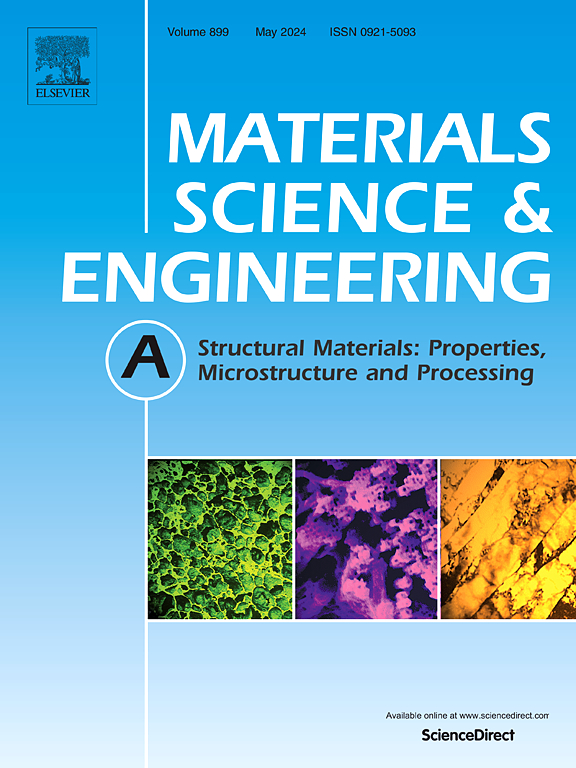Hf和C对放电等离子烧结Re0.06HfxTa1.6W0.45(TaC)y难熔中熵合金组织和力学性能的影响
IF 7
2区 材料科学
Q1 MATERIALS SCIENCE, MULTIDISCIPLINARY
引用次数: 0
摘要
高温强度和室温塑性的协同优化是耐火高熵合金在实际工程应用中的核心挑战。采用粉末冶金法制备了4种Re0.06HfxTa1.6W0.45(TaC)y耐火中熵合金(rmea)。研究了粉末冶金制备的耐火合金中氧化物和碳化物的形成机理。研究了Hf和C含量对合金组织演变和力学性能的影响。结果表明:制备的Re0.06HfxTa1.6W0.45(TaC)y合金显微组织主要由BCC基体、碳化物和分散的纳米级氧化物组成;碳化物分为M2C和MC两种,HfH2形式引入Hf元素,避免了烧结过程中氧的增加,形成分散的氧化铪,显著提高了合金的强度和耐高温软化性。Hf含量对碳化物的微观组织有重要影响。较高的Hf含量可以诱导MC碳化物的形成,提高合金的高温力学性能。由于碳化物和分散氧化物的强化,4种Re0.06HfxTa1.6W0.45(TaC)y合金在1450℃时表现出良好的高温强度和优异的耐高温软化性能。1450℃时屈服强度大于400mpa,不发生应变软化。合金在室温下的压缩断裂应变大于28%,具有良好的成形性和损伤容限。制备的耐火合金具有良好的高温力学性能和室温塑性,在超高温结构材料领域具有应用潜力。本文章由计算机程序翻译,如有差异,请以英文原文为准。
Effects of Hf and C on microstructure and mechanical properties of Re0.06HfxTa1.6W0.45(TaC)y refractory medium-entropy alloys sintered by spark plasma sintering
The synergistic optimization of high temperature strength and room temperature plasticity is the core challenge of refractory high-entropy alloys (RHEAs) in practical engineering applications. In this study, four kinds of Re0.06HfxTa1.6W0.45(TaC)y refractory medium-entropy alloys (RMEAs) were prepared by powder metallurgy process. The formation mechanism of oxides and carbides in refractory alloys prepared by powder metallurgy was studied. The effects of Hf and C contents on the microstructure evolution and mechanical properties of the alloys were investigated. The results show that the microstructure of the prepared Re0.06HfxTa1.6W0.45(TaC)y alloys is mainly composed of BCC matrix, carbides and dispersed nano-sized oxides. The carbides can be classified into two types: M2C and MC. The introduction of Hf element in the form of HfH2 can avoid the increase of oxygen during the sintering process and form dispersed hafnium oxide, which significantly improves the strength and high-temperature softening resistance of the alloy. Hf content has a key influence on the microstructure of carbides. Higher Hf content can induce the formation of MC carbides and improve the high temperature mechanical properties of the alloy. Due to the strengthening of carbides and dispersed oxides, the four Re0.06HfxTa1.6W0.45(TaC)y alloys exhibit good high temperature strength and outstanding high temperature softening resistance at 1450 °C. The yield strength at 1450 °C is more than 400 MPa, and no strain softening occurs. The compressive fracture strain of the alloy at room temperature is more than 28 %, which has good formability and damage tolerance. The prepared refractory alloy exhibits good high-temperature mechanical properties and room-temperature plasticity, and has application potential in the field of ultra-high temperature structural materials.
求助全文
通过发布文献求助,成功后即可免费获取论文全文。
去求助
来源期刊

Materials Science and Engineering: A
工程技术-材料科学:综合
CiteScore
11.50
自引率
15.60%
发文量
1811
审稿时长
31 days
期刊介绍:
Materials Science and Engineering A provides an international medium for the publication of theoretical and experimental studies related to the load-bearing capacity of materials as influenced by their basic properties, processing history, microstructure and operating environment. Appropriate submissions to Materials Science and Engineering A should include scientific and/or engineering factors which affect the microstructure - strength relationships of materials and report the changes to mechanical behavior.
 求助内容:
求助内容: 应助结果提醒方式:
应助结果提醒方式:


